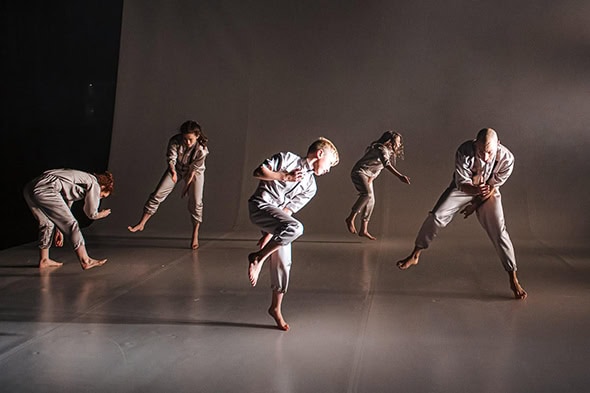SUPERFAN’s Nosedive at the Barbican Pit Theatre
Posted: November 22nd, 2019 | Author: Nicholas Minns & Caterina Albano | Filed under: Performance | Tags: Albie Gaizley-Gardiner, Ellie Dubois, JD Broussé, Kim Moore, Lachlan Payne, Michaella Fee, Michelle Ross, Nikki Rummer, Pete Lannon, Samuel Beckett | Comments Off on SUPERFAN’s Nosedive at the Barbican Pit TheatreSUPERFAN, Nosedive at the Barbican Pit Theatre, November 9

In Spring, 1967, Francis Warner, Fellow and Tutor in English Literature at St Peter’s College, Oxford conceived the idea of establishing a theatre in Oxford that would provide a platform for the work of writers, musicians, artists, performers and directors of the avant-garde and the staple diet would be new and experimental work. Warner asked Samuel Beckett if such a theatre could be named after him, to which he agreed. At the time it was supported by the leading composers, authors, artists and sculptors in the country. In 1976, St. Peter’s College passed on the management of the theatre to a charitable trust, known ever since as the Oxford Samuel Beckett Theatre Trust and in 2003 the Trust launched an award ‘in particular, to help the development of emerging practitioners engaged in bold, challenging and innovative performance and, in general, to encourage the new generation of creative artists.’ The Award allows a company or individual to create a show either for the Barbican’s Pit theatre or a site-responsive show to take place in east London or the City. SUPERFAN, ‘a new contemporary performance company’ based in Scotland, is the winner of this year’s award and its new work, Nosedive, was presented at The Pit from November 7-16.
On the face of it, there’s a disparity between the Award’s particular purpose of supporting ‘bold, challenging and innovative performance’ and SUPERFAN’s response, created and directed by Ellie Dubois and Pete Lannon. Nosedive’s proposition sounds interesting: ‘Pushing themselves to the limit, dancing with abandon, colliding into each other, children and adults perform feats and leaps that grow ever bolder, ever riskier, revealing an intricate bond of fear, resilience and recklessness.’ But in current stage performance politics, a work with ten-year-old children can neither be ‘ever riskier’ nor ‘reckless’; we need to set aside this kind of language and the publicity that simply corroborates it in order to measure the performance of Nosedive on its own terms.
What we see as we enter the theatre is Rachel O’Neill’s set with its continuous white floor and backdrop and a wall of 80 lights like portholes on one side; it’s a clean, empty space with infinite potential, while its calmness is enhanced by Kim Moore’s sound design. Only later does this light wall, designed by O’Neill and programmed by Michaella Fee, come into its own, providing what is the most memorable and poignant moment of the work. The cast has two generations, with Michelle Ross, Nikki Rummer and JD Broussé as the three older performers and Albie Gaizley-Gardiner and Lachlan Payne are the ten-year-olds. The metaphor that runs through Nosedive of younger generations ‘standing on the shoulders’ of adults to prepare for their future is also explored in the choreography. After a blackout, the lights come up on Broussé lying in a pile on the floor as if he has crash landed — the original nosedive, perhaps, from which the narrative develops. His failing, flailing efforts to levitate have a slapstick quality that is aimed at the children of all ages in the audience. Ross and Rummer help him up and they all exchange acrobatic feats as a form of dialogue that sets the physical parameters of subsequent intergenerational exchanges. When the children arrive, they initially watch their elders performing but are gradually incorporated into the action; this is where Payne stands on Rummer’s shoulders for the first time, looking out into the future. The children ‘learn’ acrobatic skills from their elders in a spirit of trust and friendship that is mutual; it’s a solicitous Payne who rescues Broussé from another failed attempt to levitate. The children then practice their skills independently, approximating poses and positions in the image of their teachers while the teachers look on. The two generations are like past and present, constantly negotiating with each other until the present is strong enough to exist on its own. There’s a magical moment when Payne is left alone on stage, looking into that light wall as all 80 lamps are turned up. This small figure full of dreams is suspended momentarily in a bright but blinding future that he cannot yet discern. He turns and runs off.
It is a moment that paradoxically transforms the work into something it isn’t. For all its intergenerational qualities, Nosedive hasn’t developed its core proposal convincingly from its egalitarian creative process in the studio — ‘embedded in playing lots of games and setting lots of tasks for each other’ — into a bold, innovative and challenging theatrical form.